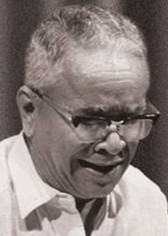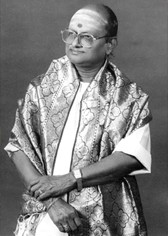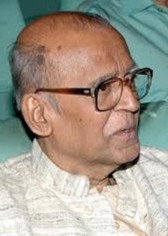COVER STORY - Music was his life by SAVITA NARASIMHAN

In an age when the nagaswara-inspired, robust, masculine, forceful music of G.N. Balasubramaniam, Alathur Brothers and Semmangudi Srinivasa Iyer held sway, Ramnad Krishnan’s choice of the veena-like, delicately modulated style of singing was a decisive deviation from the general trend. Regarded as synonymous with raga-s like Sahana, Begada and Saveri, Ramnad Krishnan was as passionate about what he believed to be aesthetic and pure music as he was steadfast in creating his own path in the midst of several performing greats of his times, no mean achievement. Yet, none could match his sense of the aesthetic and suggestive in music. Far ahead of his times, Ramnad Krishnan was a musician with a revolutionary streak, who innovated and experimented with aesthetic brilliance. Today, he is often described as an ideal musician and role model for aspiring Carnatic vocalists.
Early life and training
Krishnan was born on 14 September 1918 in Alappuzha in Kerala, to Vaidyanatha Iyer and Brihannayaki, hailing from Kooniyur in the Tirunelveli district of Tamil Nadu. When Krishnan was four months old, his father shifted from Alappuzha to Ramanathapuram (anglicised to Ramnad) district in Tamil Nadu to join the service of the Maharaja of Ramnad. Krishnan was one of eight siblings. Since the family spent many years in Ramnad, all of them prefixed Ramnad to their names. Krishnan began his first vocal lessons in Carnatic music under the tutelage of his elder brother Lakshminarayana and his guru C.S. Sankarasivam (a disciple of Harikesanallur Muthiah Bhagavatar). Among the brothers, Lakshminarayana and Venkatachalam learnt the violin, while Raghavan and Eswaran were trained to play the mridanga. By the age of seven, Krishnan had mastered Arunachala Kavi’s entire opera – the Ramanataka kriti-s. His singing prowess earned him opportunities in theatre while at school in Ramnad. Even at a young age, Krishnan had an inbuilt sense of rhythm. His guru Sankarasivam, who sang the complex Tiruppugazh in difficult tala cycles, accompanied by Pudukottai Dakshinamurthy Pillai, enjoyed making Krishnan keep the beat with his impeccable sense of rhythm.
OUR GURU - Vadyar 80: a tribute to Guru S.K. Rajarathnam Pillai by NRITHYA PILLAI

I am proud that I initiated the process of conducting ‘Vadyar 80’, a homage to Swamimalai S.K. Rajarathnam, my maternal grandfather, on the occasion of his 80th birth anniversary. I sent emails to all his students who now live in different parts of the world, and we started exchanging ideas about how best to commemorate his memory. After this initial step, my mother Jayakamala Pandiyan took up the task of overall coordination and planning.
The Vazhuvoor style has a simplistic beauty that emphasises charm and grace. Bharathathil Bharati is an example. Using his musical talent, my grandfather S.K. Rajarathnam used Bharatiar compositions to create a varnam and tillana to suit the format of a margam. This full-length production was the best choice to showcase an example of a work from his early career. We presented this on 7 January 2012 at the Narada Gana Sabha. Dancing with senior disciples of SKR like Ramya Harishankar and Jothi Raghavan was a wonderful experience. Sandhyasree Athmakuri also joined us for this programme. Since I was very young when he died, I did not have the opportunity to take individual lessons under his supervision, though he did watch me dance along with others as my mother conducted dance lessons. I lived with my grandparents and I do believe I learnt a lot just by being around him throughout my childhood.
SEMINAR - The role of the voice in Indian music

A panel discussion at the ITC-SRA seminar in January 2010 at NCPA, Mumbai.
(Sruti is happy to present edited excerpts from the above panel discussion in two parts. The late eminent musicologist Dr. Ashok Ranade led the discussion, while leading vocalists Aruna Sairam, Uday Bhawalkar and Shubha Mudgal were his fellow panelists. The first part follows)
Dr. Ashok Ranade (AR)
We begin this academic session by discussing a very important aspect of modern music making in India, and that pertains to use of the voice, and regard for the voice and vocal music in India in the light of our growing contact with other musics. The panelists, well brought up in the Indian tradition, have also been in close touch with what is happening elsewhere. We’ll try to get a close view of opinions from three different persons, practising different traditions and having different points of view perhaps.
First question
Do you think primacy of vocal music is a major feature of Indian music? If so, in what way has this influenced the content of Indian music?
Aruna Sairam (AS)
Vocal music is a major feature of Indian music and in fact, in Carnatic music we do say that every instrument, be it the violin, veena, nagaswaram or any other instrument tries to emulate the voice, the gamaka-s, the microtones and the movements, and even the aesthetic ideals of the voice. So certainly it has primacy of position.
HERITAGE - An exquisite Pallava Nataraja by CHITHRA MADHAVAN

Sculptures of Nataraja of the Chola period in stone and in metal are often seen in temples and museums. In fact, the image of this deity has come to be associated mostly with the Cholas as Nataraja was their family deity. Not many are aware that such images of the preceding Pallava era are found in some of their temples. There are a few Nataraja bronzes of this period as well.
Among the best known are those adorning the walls of the famous eighth century Kailasanatha temple in Kanchipuram. Much older than these is a stone sculpture of Nataraja in a cave temple in Siyamangalam, a village approximately 80 kilometres from Chennai, in Thellar taluk, Tiruvanna-malai district. Dating back to the seventh century AD and belonging to the reign of Mahendravarman I Pallava (c. 600-630 AD), this cave has an inscription which mentions the original name of this Siva temple as Avanibhajana Pallaveswaram. Incidentally, Avanibhajana was one of the titles of Mahendravarman I. Today, this cave shrine, enlarged over the centuries, is called the Sthambheswara or Tunandar temple.


